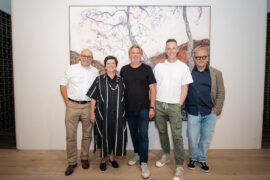The President of the International Federation of Interior Architects/Designers outlines how the association is actively building up the Interiors profession.

September 26th, 2012
The International Federation of Interior Architects/Designers (IFI) is the only organisation to represent the Interior Architecture/Design discipline on a global scale. And its task is seemingly massive.
IFI’s mission is to be a platform for the exchange and development in worldwide education, research and practice. It also looks to shape global design policy and ultimately raise the status of the profession.
With IFI turning 50 next year, its President Shashi Caan shares key milestones and challenges, and pertinent issues that have its focus in Asia.

A study tour
What have been the key milestones for IFI?
We will celebrate IFI’s 50th anniversary next year. This is significant because it helps to mark 50 years of design globalisation in our society and culture. Today, representing some 124 nations, IFI has helped to coalesce the Interiors community across the world.
Particularly significant is our Interiors Declaration. This was founded in February of 2011. With input from some 88 nations, the final document was unanimously agreed to and signed by 100 world leaders – representatives of a broad cross section of the worlds design community. This historic declaration identifies the core essence of the Interiors discipline and outlines tangible constituent criteria.
Has the IFI evolved over the years? If so, in what way?
Yes, enormously.
IFI was founded in Northern Europe by a group of ten countries who wanted to network and share information. As the federation grew, it remained a somewhat elite organisation which upheld the highest professional standards and ideals. Coincidentally, the first national Asian association to join IFI was JID of Japan.
In 2007, when I was elected President Elect, the board and I made a bold decision to expand IFI into a 21st century organisation. This meant embracing and welcoming the extended design industry. This was a necessary step given the shrinking village that is our world today and the extent of our shared resources, issues and concerns.
Today we have expanded membership categories, which allow for many organisations to participate with us. Our very unique Resource Council Member category is especially great because it provides an open channel for discourse between manufacturing and design. It fosters collaboration with companies for mutual and distinct benefits, which provide a win/win scenario for all concerned, including the general public.
Now in the middle of my second term as President, and five years later, I am very proud to say that we have successfully transitioned with a massive culture change for IFI. We are a truly global body and the highest pinnacle of our expertise.

Discussions underway
What are the most challenging issues facing the Interiors profession today? How does IFI seek to address them?
One challenge is that while shelter dates back to the dawn of humankind, and we have been addressing issues related to this aspect of our built environment for thousands of years, ironically as a professional practice, the formalised Interiors discipline is considered to be as young as just over 100 years.
Another dichotomy is that design for interiors is THE most popular of practice across the world today. However, its respect and related sense of professional confidence lags behind.
At IFI we are addressing these and other disciplinary, culture and content issues by fostering open discussion and debate. We convene the best minds from around the world to help lead important symposia in which we include all aspects of the community. We make sure to be multidisciplinary and very open minded and future focused. We research, document and publish findings. We share everything with candour and transparency.

The IFI Board. Shashi Caan – front row, extreme right
As a global body for interior architecture and design, how does IFI successfully address the diverse issues that may emerge in different countries and regions?
Our agenda items are generally those that percolate up from a minimum of six nations. Thus we address the pervasive issues pertinent and shared by many. We exist to most fairly address the commonalities and we do not take sides. We always aspire to build consensus. In this case we are akin to the UN. We are high level and care deeply about quality of life impacted by and through design.
What main areas does IFI seek to focus on in Asia?
Design and design sophistication is rapidly advancing in Asia. We know that Asia seeks to grow out of the ‘made in Asia’ designation to ‘designed in Asia’. To do this a depth and breadth of education – through all aspects of society – is necessary. Beyond the ability to think and to think creatively, problem solve elegantly and to manage beauty, art, technology and science with equal ease, the contemporary designer must be nimble, versatile, cosmopolitan and totally literate. IFI seeks to help expand and deepen this knowledge while helping to foster ever greater pride in the national heritage and local culture.
IFI
ifiworld.org
Catch Shashi Caan at Saturday in Design Singapore on 6 October.
INDESIGN is on instagram
Follow @indesignlive
A searchable and comprehensive guide for specifying leading products and their suppliers
Keep up to date with the latest and greatest from our industry BFF's!

At the Munarra Centre for Regional Excellence on Yorta Yorta Country in Victoria, ARM Architecture and Milliken use PrintWorks™ technology to translate First Nations narratives into a layered, community-led floorscape.

Sydney’s newest design concept store, HOW WE LIVE, explores the overlap between home and workplace – with a Surry Hills pop-up from Friday 28th November.
Designed by the world-renowned industrial design house, Giugiaro Design for Okamura Corporation in Japan.

Kerstin Thompson Architects’ work at Bundanon recently marked its one-year anniversary. With Thompson having recently been awarded the AIA Gold Medal, it’s a fitting time for a mini-retrospective, continued here in this second part.
The internet never sleeps! Here's the stuff you might have missed

Indesign Media is aware of recent reports raising serious concerns about Australian architectural photographer Derek Swalwell.

Eco Outdoor recently brought together developers, sustainability experts and local architects such as Adam Haddow to discuss design fundamentals, carbon targets and long-term thinking.